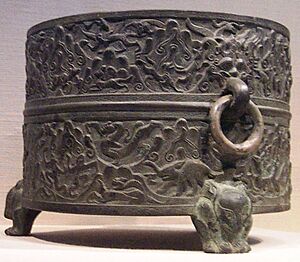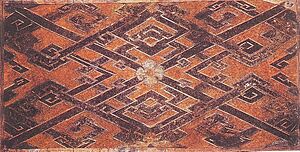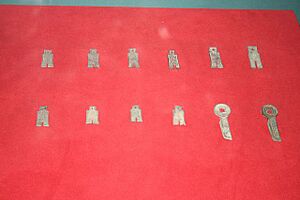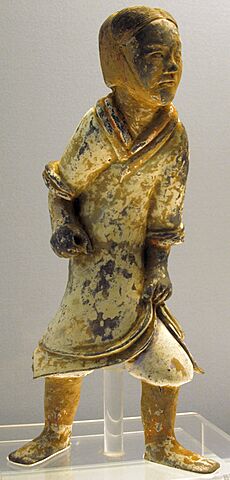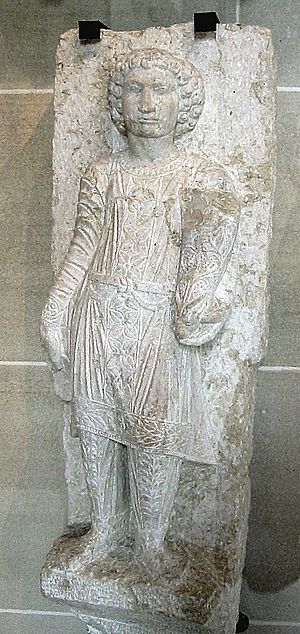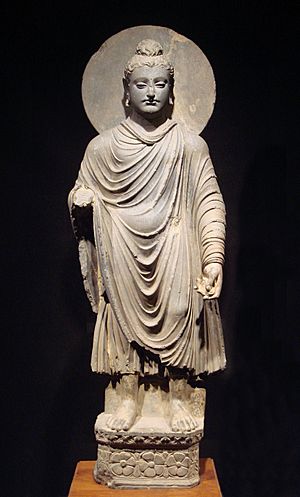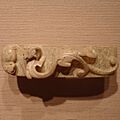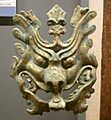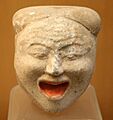History of the Han dynasty facts for kids
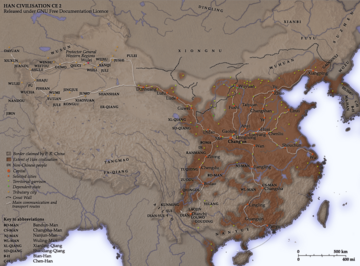
The Han dynasty (206 BCE – 220 CE) was a very important time in Chinese history. It was the second big empire in China, coming after the Qin dynasty. The Han Dynasty was started by a leader named Liu Bang. This long period is split into two main parts: the Western Han (206 BCE – 9 CE) and the Eastern Han (25–220 CE). There was a short break in between when Wang Mang ruled his own Xin dynasty (9–23 CE). The names "Western" and "Eastern" come from where their capital cities were located: Chang'an for Western Han and Luoyang for Eastern Han.
During the Han Dynasty, China grew a lot in many ways. Its culture became stronger, its government tried new things, and its economy became very successful. There were also many amazing inventions and discoveries. The empire expanded its land, especially because of conflicts with groups like the Xiongnu, who were nomadic people from the northern grasslands. At first, the Han emperors had to make peace with the Xiongnu through agreements and royal marriages. But later, Emperor Wu of Han launched military campaigns that pushed the Xiongnu back and expanded China's borders even further. The Han Empire reached as far as modern Xinjiang, Yunnan, northern Vietnam, and North Korea. Trade routes, like the famous Silk Road, connected China with distant lands like the Parthian Empire. This was also when Buddhism first arrived in China.
Over time, the Han court faced challenges from within. Powerful families connected to the empresses and palace eunuchs gained a lot of influence. This led to political problems and even civil war. Eventually, in 220 CE, the last Han emperor gave up his throne. People believed he had lost the "Mandate of Heaven," which meant Heaven no longer supported his rule. After the Han Dynasty, China was divided into three separate states, known as the Three Kingdoms.
Contents
How the Han Dynasty Began
The Fall of the Qin Dynasty
The Qin dynasty had united China by conquering six other states in 221 BCE. Its first emperor, Qin Shi Huang, created a strong, central government. But his rule was very strict. When Qin Shi Huang died in 210 BCE, rebellions started across China. One important rebellion was led by Chen Sheng and Wu Guang, who were conscripted soldiers. Even though their rebellion failed, it inspired others to rise up.
Two key leaders emerged: Xiang Yu, a noble from the state of Chu, and Liu Bang, a commoner who supervised convicts. They both fought against the Qin. While Xiang Yu was busy fighting, Liu Bang managed to capture the Qin capital, Xianyang. He was smart and didn't let his soldiers loot the city, showing respect for the people.
The Fight Between Chu and Han
After the Qin Dynasty fell, Xiang Yu became the most powerful leader. He divided China into 18 kingdoms and called himself the "Hegemon-King of Western Chu." He tried to have Liu Bang killed at a feast, but Liu Bang escaped. Xiang Yu then gave Liu Bang a less important area called the Kingdom of Han.
This led to a four-year war between Liu Bang's Han forces and Xiang Yu's Chu forces, known as the Chu–Han Contention. Liu Bang faced many challenges, including having his family captured by Xiang Yu. But Liu Bang was persistent and gathered more allies. His general, Han Xin, conquered other kingdoms, weakening Chu.
In 203 BCE, Xiang Yu offered a truce, splitting China into two halves. Liu Bang accepted, but the peace didn't last. In 202 BCE, at the Battle of Gaixia, Liu Bang's forces surrounded Xiang Yu. Xiang Yu was defeated and died. Liu Bang then became the emperor, known as Emperor Gaozu of Han.
Emperor Gaozu's Rule
Building the New Empire
Emperor Gaozu first made Luoyang his capital, but then moved it to Chang'an (near modern Xi'an). Chang'an had better natural defenses and supply routes. He set up a government similar to the Qin, with a main cabinet and nine ministries. Even though Han leaders criticized Qin's harsh laws, their first law code borrowed many ideas from the Qin.
Emperor Gaozu directly ruled the western part of the empire. In the eastern part, he created 10 semi-independent kingdoms and gave them to his most loyal followers. However, he soon replaced most of these leaders with members of his own royal family (the Liu clan) because he worried about rebellions. These kingdoms had their own governments, but they had to send taxes and information to the central government. They also needed permission from the capital to use their armies.
Dealing with the Xiongnu
The Xiongnu were a powerful nomadic group to the north. Their leader, Modu Chanyu, had built a large empire. The Han feared Xiongnu attacks and tried to stop them from getting Chinese goods like iron weapons. Emperor Gaozu banned trade with them. This made Modu Chanyu angry, and he attacked. In 200 BCE, Emperor Gaozu personally led his army but was surrounded for seven days at the Battle of Baideng. He was forced to retreat.
After this defeat, Emperor Gaozu agreed to a peace treaty and marriage alliance with the Xiongnu, called the heqin agreement. This meant the Han would send gifts like silk and wine to the Xiongnu every year. The Han hoped these gifts would make the Xiongnu less aggressive. Even though the treaty said both sides were equal, the Han was actually the weaker partner because they had to pay tribute. The Xiongnu still often raided the Han's northern borders.
Empress Dowager Lü's Power
Emperor Hui's Short Reign
When Emperor Gaozu died in 195 BCE, his son Emperor Hui of Han became emperor. But Gaozu's widow, Empress Lü Zhi, became the powerful empress dowager. She had a potential rival to the throne poisoned. Emperor Hui was young and didn't dare to disobey his mother.
During Emperor Hui's short rule, the capital city of Chang'an got strong defensive walls. These walls were 12 meters (40 feet) tall and were built by 150,000 workers. Emperor Hui also removed old Qin laws that banned certain books. He continued the peace agreement with the Xiongnu.
Empress Lü's Regency
Emperor Hui didn't have any children with his empress. So, after his death in 188 BCE, Empress Lü Zhi, now the grand empress dowager, chose his successors from his other sons. She put two young emperors on the throne, but they were just puppets. She was the real ruler. She even appointed members of her own family (the Lü clan) as kings and important military and government officials, which went against Emperor Gaozu's rules.
The court under Empress Lü struggled with a Xiongnu invasion and also angered the King of Nanyue (in modern northern Vietnam) by banning trade. After Empress Dowager Lü died in 180 BCE, officials feared the Lü clan would try to take over the empire completely. They launched a coup, removing the Lü clan from power. Emperor Wen of Han was chosen as the new emperor.
Emperors Wen and Jing
New Policies and Stability
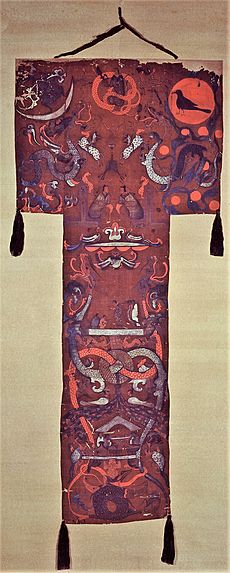
The period of Emperor Wen of Han (180–157 BCE) and his son Emperor Jing of Han (157–141 BCE) was a time of peace and growth for the Han Empire. The central government gained more control. To be different from the harsh Qin rule, they offered many amnesties (pardons) and lowered taxes on farm produce.
Their policies were influenced by a philosophy called Huang-Lao, which was an early form of Taoism. This philosophy suggested that rulers should interfere as little as possible in daily life, allowing the government to run smoothly. Over time, the number of kingdoms was increased, but their sizes were reduced. This was done by taking land from kingdoms that rebelled or didn't have an heir, and turning them into smaller kingdoms or new government-controlled areas.
The Rebellion of Seven States
Emperor Jing's brother, Liu Xian, was accidentally killed by the future Emperor Jing during a board game. This made Liu Xian's father, Liu Pi, the King of Wu, very angry. King Liu Pi was also worried because Emperor Jing was reducing the size of the kingdoms.
So, in 154 BCE, the King of Wu led a large rebellion with six other kingdoms against the Han. This was called the Rebellion of the Seven States. However, the Han army, led by Zhou Yafu, was strong and quickly put down the revolt. Many kingdoms were abolished or made much smaller. Emperor Jing then made a rule that kings could no longer have their own independent officials; central government officials would now manage their courts. Emperor Wu, who came after, reduced their power even more by making kings divide their land among all their sons, not just the oldest.
Dealing with the Xiongnu Again
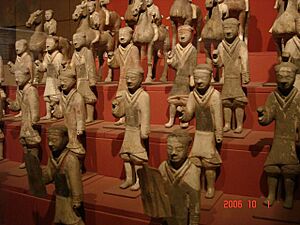
The Xiongnu continued to be a threat. Their leader, Modu Chanyu's successor, Laoshang Chanyu, renewed the heqin agreement and opened border markets. This helped reduce Xiongnu raids. However, the Xiongnu still sometimes broke the treaty. While the Xiongnu were busy conquering other nomadic tribes, the Han quietly built up its own cavalry forces, preparing for a future challenge.
Emperor Wu's Powerful Reign
Confucianism and Government Jobs

Even though early Han emperors didn't fully follow Confucius's ideas, they did start recruiting talented men for government service. Emperors Wen and Jing brought Confucian scholars to court. When Emperor Wu became emperor in 141 BCE, his grandmother, Grand Empress Dowager Dou, still had a lot of power and preferred Huang-Lao Daoism. But after her death in 135 BCE, things changed a lot.
Emperor Wu supported the ideas of Dong Zhongshu, a philosopher who combined Confucian ethics with ideas about yin and yang and the Five Elements. This system explained how Heaven, Earth, and humans were connected and justified the emperor's rule. In 136 BCE, Emperor Wu made Confucian texts the main focus of study. In 124 BCE, he started the Imperial University, where scholars taught 50 students. This was the beginning of China's famous civil service examination system. Over time, this university grew, and by the 2nd century CE, it had 30,000 students. The invention of papermaking by Cai Lun in 105 CE made books cheaper and helped more people get an education to join the government.
Wars Against the Xiongnu
Emperor Wu decided it was time to stop the heqin policy and fight the Xiongnu. After a failed attempt to trap the Xiongnu leader, the Han began a full-scale war in 133 BCE. Han generals like Wei Qing and Huo Qubing led huge armies. In 127 BCE, they took back the Ordos Desert from the Xiongnu. In 121 BCE, Huo Qubing pushed them out of the Qilian Mountains. At the Battle of Mobei in 119 BCE, the Han forced the Xiongnu leader to flee north of the Gobi Desert. To support these large armies, the government encouraged people to breed horses by offering tax breaks.
Expanding the Empire

After defeating the Xiongnu, the Han gained a lot of new land, including the Hexi Corridor. This cut off the Xiongnu from their allies. New government areas were set up and filled with Han settlers. The Han also built military outposts and agricultural garrisons (farms run by soldiers) to support their armies and protect trade routes like the Silk Road. The Great Wall of China was extended far to the west, and parts of it can still be seen today. Emperor Wu's forces conquered about 4.4 million square kilometers (1.7 million square miles) of new land, which was the largest expansion in Chinese history.
Trade and Diplomacy
In 139 BCE, the Han diplomat Zhang Qian traveled west to find allies against the Xiongnu. He didn't find allies, but he discovered many new countries that the Chinese didn't know about, including parts of the Hellenistic civilization (lands influenced by ancient Greece). Zhang Qian reported on places like Fergana, Sogdiana, and Bactria. He also learned about India and the Arsacid Empire (Parthia). These travels opened up new trade routes, and Chinese silk was already being imported by these western countries. The earliest Roman glassware found in China dates to this time, suggesting trade connections.
The Han also fought for control of the Tarim Basin in Central Asia, which was important for the Silk Road. They gained control over several states there. To the south, Emperor Wu conquered Nanyue (modern Guangdong, Guangxi, Hainan Island, and northern Vietnam) in 111 BCE. He also invaded the Dian Kingdom in Yunnan. In Korea, a Han expedition in 108 BCE established four commanderies, bringing parts of northern Korea under Chinese influence.
Economic Changes

To pay for his many military campaigns and new colonies, Emperor Wu changed earlier policies. The government took control of the private industries of salt mining and iron manufacturing in 117 BCE. They also created a government monopoly over liquor in 98 BCE, but this was later ended.
A government official named Sang Hongyang created an "equable transportation" system. This meant the government would buy grain when it was cheap and sell it at a low price when private merchants tried to charge more. This was meant to stop price speculation. However, these monopolies and policies were criticized for hurting merchants and farmers, and they didn't last into the Eastern Han period. Emperor Wu also raised taxes and introduced a new bronze coin that became the standard for centuries.
Later Western Han Period
Huo Guang's Regency
After Emperor Wu died, his young son Emperor Zhao of Han became emperor. Emperor Wu had trusted Huo Guang, a powerful general, to act as a regent (someone who rules for a young emperor). Huo Guang shared power with two other officials at first, but soon he became the most powerful. He was popular because he reduced some of Emperor Wu's taxes.
When Emperor Zhao died without an heir, Huo Guang chose a nephew, Prince He of Changyi, to be the new emperor. But Prince He was quickly removed for not being suitable to rule. Huo Guang then chose Emperor Xuan of Han, who was Emperor Wu's great-grandson. Huo Guang remained regent until his death in 68 BCE. However, two years later, Huo Guang's family was accused of plotting against the throne and removed from power. This was partly Emperor Xuan's revenge because Huo Guang's wife had poisoned his beloved first empress.
Reforms and Frugality
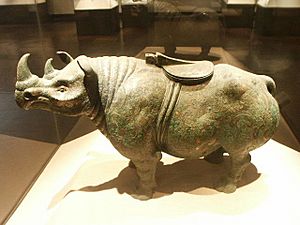
During Emperor Wu's time, the "Modernist Party" favored strong government control over the economy, high taxes, and an aggressive foreign policy. After Huo Guang's regency, the "Reformist Party" gained influence. They wanted to end government monopolies, limit government involvement in the economy, have a more moderate foreign policy, and reduce spending. They also wanted to return to older ideals of rewarding good service.
The Reformists managed to abolish the salt and iron monopolies in 44 BCE, though they were brought back later. They also cancelled many lavish events and entertainments that Emperor Wu had used to impress foreign guests, saying they were too expensive. Emperors Yuan and Cheng also reduced the severity of punishments and made legal procedures simpler. Emperor Cheng also changed state-sponsored religion, focusing worship on the supreme god Shangdi.
Foreign Relations and Peace
In the 1st century BCE, the Xiongnu faced problems with their own leadership, which allowed the Han to strengthen its control over the Western Regions (Central Asia). The Han established the Protectorate of the Western Regions in 60 BCE to oversee their activities and relations with the small kingdoms there.
A major turning point came when a Xiongnu leader named Huhanye Chanyu decided to seek Han help and become a Han vassal (a state that pledges loyalty and pays tribute). He visited Emperor Xuan in 51 BCE and was treated as an honored guest, receiving many valuable gifts. This was a big change from the earlier heqin agreement, where the Han had to pay tribute. This new arrangement was much better for the Han, even though it still involved giving gifts. Another Xiongnu leader, Zhizhi Chanyu, who was Huhanye's rival, was killed by Han generals in 36 BCE. This further secured Han's influence.
Wang Mang Takes Over
Wang Mang Seizes Power

For many years, the Wang family, relatives of Empress Wang Zhengjun, held a lot of power as regents. Wang Mang, a nephew of Empress Dowager Wang, became the most powerful regent. When Emperor Ai of Han died without a son, Wang Mang became regent for the child emperor Emperor Ping of Han. Emperor Ping also died young.
Wang Mang then started a propaganda campaign, claiming that Heaven wanted the Han Dynasty to end. On January 10, 9 CE, he announced that the Han Dynasty was over and declared himself emperor of a new dynasty called the Xin dynasty.
Wang Mang's Reforms
Wang Mang had big plans to bring China back to a "golden age" he imagined from the early Zhou dynasty. He tried many reforms, including banning slavery and nationalizing land ownership, giving a standard amount of land to each family. However, these reforms faced widespread protest and were later cancelled.
Wang Mang also introduced new types of currency, but these often lowered the value of money. He renamed many government offices and regions. While some of his ideas were similar to earlier Han policies, many of his reforms caused problems and led to his downfall.
Foreign Relations Under Wang Mang
Wang Mang's decision to demote the Xiongnu leader to a lower rank caused conflict. He gathered a large army on the northern border, which made the Xiongnu back down for a while. But raids continued, and Wang Mang even executed a Xiongnu prince held hostage.
The Tarim Basin kingdom of Yanqi rebelled against Wang Mang's rule in 13 CE. Wang Mang sent forces to put down the rebellion, keeping the region under Chinese control until his rule ended. He also extended Chinese influence over Tibetan tribes and fought against an early Korean state. However, as rebellions grew in China, his control over these distant regions weakened.
The Han Dynasty Returns
Natural Disasters and Civil War
Before 3 CE, the Yellow River changed its course due to silt buildup, causing massive floods. A second flood in 11 CE changed the river's path again. These floods displaced thousands of starving peasants, who formed groups of bandits and rebels, most famously the Red Eyebrows. Wang Mang's armies tried to stop these rebellions but failed.
Liu Yan, a descendant of Emperor Jing, led a group of gentry (wealthy landowners) who rebelled against Wang Mang. His cousin, Liu Xuan, was declared emperor in 23 CE. Liu Yan's brother, Liu Xiu, became famous for his military skills at the Battle of Kunyang, turning the tide against Wang Mang. Wang Mang was killed in 23 CE as his capital was attacked.
The Gengshi Emperor tried to rule from Luoyang, but the Red Eyebrows rebelled against him, captured Chang'an, and killed him.
Reuniting the Empire Under Guangwu

While working for the Gengshi Emperor, Liu Xiu gained many followers. He declared himself emperor on August 5, 25 CE, and made Luoyang his capital. He became known as Emperor Guangwu of Han. He then spent years defeating other warlords and reuniting China. He forced the Red Eyebrows to surrender in 27 CE. By December 36 CE, his forces had defeated the last major rival, Gongsun Shu, in modern Sichuan.
The return of the Han Dynasty relied heavily on the support of powerful landowners. This is one reason why the capital was moved to Luoyang, which was in the central plains. Since Chang'an was west of Luoyang, historians call the first period Western Han and the second period Eastern Han. The population of China was nearly 58 million in 2 CE. By 140 CE, it was about 48 million, showing a big shift of people from northern to southern China due to natural disasters and wars.
Policies of Eastern Han Emperors
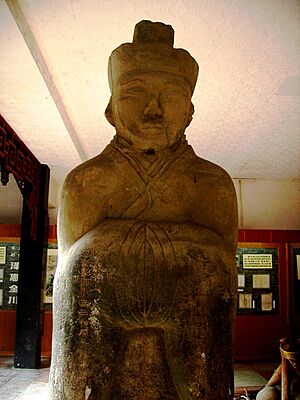
Emperor Guangwu brought back the standard five shu coin from Western Han. He also taxed private manufacturers heavily since the salt and iron monopolies were gone. He allowed peasants to pay a tax to avoid military service or forced labor, making hired labor more common.
Emperor Ming of Han (57–75 CE) tried to stabilize prices by having the government buy grain when it was cheap and sell it when prices were high. He also worked on repairing dams and canals to control the Yellow River. Emperor Ming supported education and built a school for young nobles.
Emperor Zhang of Han (75–88 CE) faced a cattle epidemic and offered disaster relief. He also made legal reforms and lightened punishments. He supported a different tradition of Confucian scholarship. A major reform during his reign was the reintroduction of a more accurate Chinese calendar.
Emperor He of Han (88–105 CE) was open to different scholarly traditions. He also showed interest in history and commissioned Lady Ban Zhao to complete the Book of Han, a major historical work. When natural disasters occurred, Emperor He provided relief by cutting taxes, opening granaries, and offering loans. He even personally inspected prisons, believing that injustice could cause natural disasters.
Foreign Relations and the Split of the Xiongnu
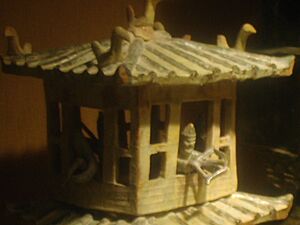
In 40 CE, the Vietnamese Trưng Sisters led an uprising in northern Vietnam, but they were defeated by the Han general Ma Yuan.
A major event was the split of the Xiongnu. In 48 CE, a Xiongnu prince named Bi declared himself a rival leader, creating the Northern Xiongnu and Southern Xiongnu. Like before, the Southern Xiongnu turned to the Han for help and became a Han vassal. They were settled in Han's northern regions and overseen by a Han official. The Northern Xiongnu were not accepted into the Han's tributary system.
The Han Dynasty also worked to regain control of the Tarim Basin. In 73 CE, Han forces defeated the Northern Xiongnu and established a military garrison. However, the Xiongnu and their allies fought back, and the Han had to withdraw for a time. In 89 CE, the Han general Dou Xian led a major expedition that chased the Northern Xiongnu leader into the Altai Mountains, greatly weakening them.
General Ban Chao was very important in the Western Regions. He formed alliances, including with the Kushan Empire (in modern North India and Central Asia), to put pressure on other states. He was appointed Protector General of the Western Regions until 101 CE.
The Arsacid Empire (Parthia) sent gifts and envoys to the Han court, bringing exotic animals like ostriches and lions. In 97 CE, Ban Chao sent an emissary, Gan Ying, to try and reach the Roman Empire. He didn't make it all the way, but he gathered information about Rome. Roman glass has been found in Han tombs, showing trade connections.
The first known diplomatic mission from Japan came in 57 CE. Buddhism became more popular in China during the 2nd century CE, brought by monks from Parthia and Kushan. In 166 CE, Emperor Huan even made sacrifices to both Laozi and the Buddha.
Court Politics and Eunuchs
During Emperor Ming's reign, there were some conflicts with imperial family members. But a bigger problem for the dynasty was the growing power of eunuchs in the palace. In 92 CE, Emperor He, with the help of eunuchs led by Zheng Zhong, overthrew the powerful Dou family (his mother's relatives) who had been controlling him. This was the first time eunuchs played such a big role in Eastern Han politics.
Middle Eastern Han Period
Empress Deng Sui and Eunuch Influence

After Emperor He died, his widow, Empress Deng Sui, became empress dowager and chose his infant son and then a young nephew to be emperors. She was the real ruler until her death in 121 CE. After she died, Emperor An accused her family of treason and removed them from power.
The Yan family of Empress Yan Ji, Emperor An's wife, and powerful eunuchs gained control. They even had Emperor An's young heir removed. When Emperor An died, Empress Dowager Yan chose another child emperor. But a eunuch named Sun Cheng led a palace coup, killed opposing eunuchs, and put the original heir, Emperor Shun of Han, on the throne. Sun Cheng then put Empress Dowager Yan under house arrest and exiled her family.
Later, the Liang family, relatives of Empress Liang Na, gained power. Her brother, Liang Ji, became a powerful regent. When Emperor Huan became emperor and Liang Ji tried to control his new favorite consort, Emperor Huan used eunuchs to overthrow Liang Ji. Emperor Huan died without a direct heir, and his empress dowager chose Emperor Ling of Han to be the next emperor.
Reforms and Policies of Middle Eastern Han
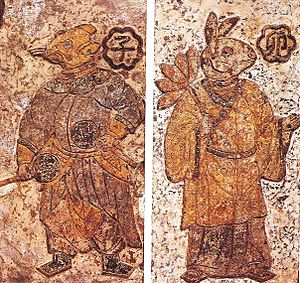
Empress Dowager Deng's government tried to help people during natural disasters by reducing taxes and sending food. She also cut down on luxury spending. To raise money, she even allowed some government jobs and noble ranks to be sold. This practice continued and became very common during Emperor Ling's reign.
Emperor An continued disaster relief programs. Financial problems worsened during Emperor Shun's reign. However, his court oversaw major disaster relief efforts, helped by a new invention in 132 CE: a seismometer by the court astronomer Zhang Heng. This device could detect earthquakes hundreds of kilometers away. Emperor Shun also repaired the Imperial University.
Under Liang Ji's influence, the Imperial University introduced a formal examination system for government jobs. Despite some positive reforms, Liang Ji was known for corruption. When Emperor Huan overthrew Liang Ji, students at the Imperial University protested against the eunuchs who helped Huan. Emperor Huan then moved away from Confucianism and supported Huang-Lao Daoism. As the economy worsened, Emperor Huan spent a lot on new palaces and concubines. Emperor Ling also relied heavily on eunuchs and spent his time on personal interests rather than governing.
Foreign Relations and the Xianbei
The Han often struggled to maintain control over the Western Regions, especially due to rebellions by the Qiang people. These rebellions were costly and sometimes cut off Han's access to Central Asia.
A new powerful group, the Xianbei people, rose to power in the northern steppes after the Northern Xiongnu were defeated by the Han and moved west. The Xianbei quickly took over the empty territories and grew into a large federation. Although they sometimes raided the Han for better trade, their leader Tanshihuai refused to become a Han vassal. The Xianbei Federation became very powerful in the 2nd century CE.
Buddhism became more popular in China during the 2nd century CE. Monks like An Shigao and Lokaksema translated Buddhist texts into Chinese. In 166 CE, Emperor Huan made sacrifices to both Laozi and the Buddha. The Book of Later Han also records that Romans reached China by sea in 166 CE, bringing gifts to Emperor Huan's court. These were likely Roman merchants, not official diplomats.
Decline of Eastern Han
The Partisan Prohibitions
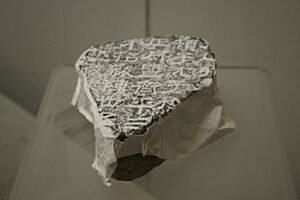
In 166 CE, officials who opposed the palace eunuchs were accused of treason. Emperor Huan arrested them, and they were forbidden from holding any government jobs. They were called "partisan" (黨人).
After Emperor Huan's death, powerful officials like Dou Wu and Chen Fan tried to remove the leading eunuchs, accusing them of corruption. However, the eunuchs discovered their plot. They quickly took control of the young Emperor Ling and arrested Empress Dowager Dou. The eunuchs then killed Dou Wu and Chen Fan.
The eunuchs renewed the ban on officials who opposed them, preventing hundreds more from serving in government. They also sold government jobs and gained control of the military. Emperor Ling even called two powerful eunuchs, Zhao Zhong and Zhang Rang, his "mother" and "father." The eunuchs built huge mansions and had a lot of influence. The bans on officials were finally lifted in 184 CE because the court feared that these banned gentry would join a new rebellion.
The Yellow Turban Rebellion
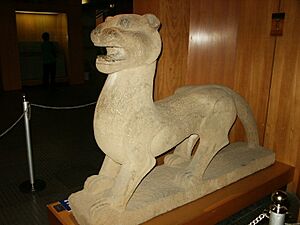
In the later years of the Han Dynasty, new religious groups appeared. Some of these groups challenged the government. One important group was the Yellow Turban Daoists, led by Zhang Jue. They believed that illness was caused by sins and that they would bring about a peaceful new era.
In 184 CE, Zhang Jue and his hundreds of thousands of followers, who wore yellow cloths on their heads, launched a rebellion across eight provinces. They had some early successes, but their leaders were killed by the end of 184 CE. Smaller groups of Yellow Turbans continued to revolt. Many generals who raised armies to fight the rebellion never disbanded their forces. They used these armies to gain their own power, which contributed to the fall of the Han Dynasty.
The Downfall of the Eunuchs
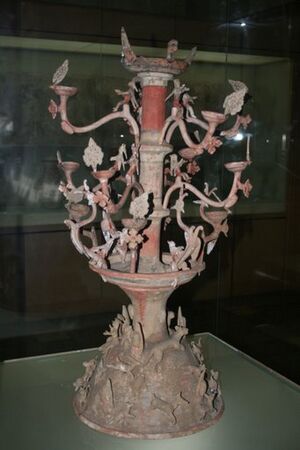
He Jin, the half-brother of Empress He, became the General-in-Chief during the Yellow Turban Rebellion. He gained control of the army and palace guards. After Empress He's son became emperor, He Jin plotted with an officer named Yuan Shao to remove the eunuchs. They ordered generals to march towards the capital to force the Empress Dowager to dismiss the eunuchs.
However, the eunuchs found out about the plan. They tricked He Jin into coming to the palace and killed him. Then, Yuan Shao and his brother attacked the palaces, killing thousands of eunuchs. Some eunuchs managed to flee with the young emperor and his brother, but they also died.
The Rise of Warlords
Dong Zhuo, a general who had been called to Luoyang by Yuan Shao, took control of the capital. He saw the city in flames and found the young emperor wandering. Dong Zhuo quickly gained power. He forced the emperor to step down and put the emperor's brother, Emperor Xian of Han, on the throne instead. Dong Zhuo then poisoned the Empress Dowager and the former emperor.
Yuan Shao formed a group of commanders and former officials to challenge Dong Zhuo. Dong Zhuo burned Luoyang to the ground and forced the imperial court to move to Chang'an. Dong Zhuo was later killed by his adopted son, Lü Bu.
Emperor Xian fled Chang'an in 195 CE and returned to Luoyang. By this time, the empire was divided among eight powerful warlords. Even though these warlords still claimed loyalty to the Han emperor, they were really fighting for their own power.
The End of the Han Dynasty
Cao Cao, a general who had fought in the Yellow Turban Rebellion, took Emperor Xian from Luoyang to his headquarters in Xuchang in 196 CE. Cao Cao gained more and more power. He became the Imperial Counselor and Chancellor. In 213 CE, he was made the Duke of Wei, and in 216 CE, he became the King of Wei, even though only members of the Liu family were supposed to be kings. However, he never officially removed Emperor Xian from the throne.
After Cao Cao died in 220 CE, his son Cao Pi inherited his title. People believed that the Han Dynasty had lost the "Mandate of Heaven." On December 11, 220 CE, Emperor Xian agreed that the Han Dynasty had ended and gave up his throne to Cao Pi. This created the state of Cao Wei. Soon after, China was divided into three separate states: Cao Wei, Shu Han, and Eastern Wu. This period is known as the Three Kingdoms.
See also
- Han dynasty imperial family tree
- History of China
- Women in Han China
Images for kids
-
Qin dynasty soldiers from the Terracotta Army of Qin Shi Huang's mausoleum, located near Xi'an
-
A gilded belt clasp with turquoise, dated Warring States period to early Han dynasty, 4th to 3rd centuries BCE
-
Bronze cowrie container, Western Han dynasty (202 BC – 9 AD), Yunnan Provincial Museum, Kunming; cowrie shells were used as an early form of money in this region of China and were kept in elaborately decorated bronze containers such as this one, surmounted by a freestanding gilded horseman who is encircled by four oxen, that are approached in turn by two tigers climbing up on opposite sides of the container.
-
Seated earthenware figures playing on a model liubo board game, dated to the Eastern Han Era
-
A lacquerware-painted scene on a 1st or 2nd century CE basket from the Han colony at Lelang (modern North Korea) showing historical paragons of filial piety
-
The Portland Vase, Roman cameo glass, 5–25 CE; Roman glass has been found in Han Chinese tombs dating from the reign of Emperor Wu onwards.
-
A gilded bronze handle (now disconnected from the ware) in the shape of a dragon's head and neck, Eastern Han Era
-
A jade-carved sword scabbard slide with a dragon design, from the Western Han Era
-
Bronze Chinese coins, in the shape of knives and spades, from the reign of Wang Mang
-
This pottery model of a palace found in a Han dynasty tomb displays outer walls and courts, gate houses, towers, halls, verandas, and roof tiles.
-
An earthenware pouring vessel in the shape of a goose, painted with pigment, Western Han Era
-
A Han dynasty ceramic ox-drawn cart figurine
-
Vima Takto (r. c. 80–90 CE), ruler of the Kushan Empire; the Kushan emperors minted copper coins in imitation of the silver denarii of Augustus (r. 27 BCE – 14 CE), first emperor of the Roman Empire
-
Two black-and-red painted, footed ceramic wares decorated with acrobat figurines, each one balancing himself on both hands, dated to the Western Han Era
-
Statue of the Buddha from Gandhara, then under the Kushan Empire, 1st–2nd century CE



